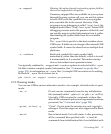All options and command-line arguments you give are processed in sequential order.
The order makes a difference when the `-x' option is used.
2.1.1 Choosing files
When GDB starts, it reads any arguments other than options as specifying an executable
file and core file (or process ID). This is the same as if the arguments were specified by
the '-se' and '-c' options respectively. (GDB reads the first argument that does not
have an associated option flag as equivalent to the '-se' option followed by that
argument; and the second argument that does not have an associated option flag, if
any, as equivalent to the '-c' option followed by that argument.)
If GDB has not been configured to included core file support, such as for most embedded
targets, then it will complain about a second argument and ignore it.
Many options have both long and short forms; both are shown in the following list.
GDB also recognizes the long forms if you truncate them, so long as enough of the
option is present to be unambiguous. (If you prefer, you can flag option arguments
with `--' rather than `-', though we illustrate the more usual convention.)
-symbols file
-s file
Read symbol table from file file.
-exec file
-e file
Use file file as the executable file to execute when
appropriate, and for examining pure data in
conjunction with a core dump.
-se file
Read symbol table from file file and use it as the
executable file.
-core file
-c file
Use file file as a core dump to examine.
-c number Connect to process ID number, as with the attach
command (unless there is a file in core-dump format
named number, in which case `-c' specifies that file as
a core dump to read).
-command file
-x file
Execute GDB commands from file file. See “Command
files” (page 289).
-directory directory
-d directory
Add directory to the path to search for source files.
26 Getting In and Out of GDB


















